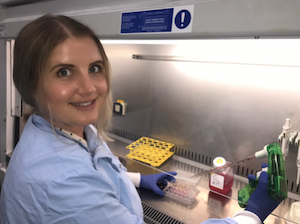Liver Disease and A-T
Principle Researcher: Dr Sarah Withey
Institute: AIBN (Australian Institute for Bioengineering and Nanotechnology) within The University of Queensland
Cost: $1100,000 over 3 years
Commencement: February 2020
 A-T patients have a high prevalence of non-alcoholic fatty liver disease (NAFLD). Fatty Liver Disease, which is when the cells of the liver store too much fat, occurs when fat accumulates due to increased production or intake and/or because normal fat metabolism processes which remove fat are inefficient.
A-T patients have a high prevalence of non-alcoholic fatty liver disease (NAFLD). Fatty Liver Disease, which is when the cells of the liver store too much fat, occurs when fat accumulates due to increased production or intake and/or because normal fat metabolism processes which remove fat are inefficient.
Excessive fat storage interferes with the normal activity of the liver and can lead inflammation and scarring (known as fibrosis) and even liver failure. Unfortunately, we don’t yet understand why Fatty Liver Disease is so much more prevalent in A-T patients, and that’s why Dr Withey is tackling this problem.
What is Dr Withey proposing to do?
Dr Withey is generating liver cell types, called hepatocytes, from induced pluripotent stem cells (iPSCs).
iPSCs have been made from the skin of patients with A-T, some of which have been ‘gene-corrected’, meaning the faulty ATM gene has been restored to normal.
Dr Withey, who has extensive experience in liver cell biology and differentiation, will direct gene-corrected and A-T patient iPSCs to hepatocyte-like cells using her established protocols. She has already confirmed that this technique generates functional hepatocytes from both gene corrected and patient cell lines.
To identify what differences there are between the gene-corrected versus A-T patient hepatocyte-like cells, Dr Withey will measure the ‘health’ of the cells through liver function tests including protein secretion and enzyme activity. Because her hepatocyte differentiation protocol mimics human embryo development, she can even analyse the cells are different stages of ‘maturation’ to identify when any differences arise.
Why might A-T liver cells be impaired?
Dr Withey will specifically focus on the processes of fat (lipid) metabolism and storage in the generated hepatocyte-like cells.
We already know that mitochondria and peroxisomes (which are organelles within human cells), are needed for efficient lipid metabolism.
We also know that ATM, the protein which is deficient in A-T patients, is known to be important in normal mitochondrial and peroxisomal activity.
Dr Withey is therefore going to investigate whether ATM dysfunction in A-T patient hepatocyte-like cells contributes to impaired peroxisome and mitochondrial function leading to reduced lipid metabolism in hepatocytes.